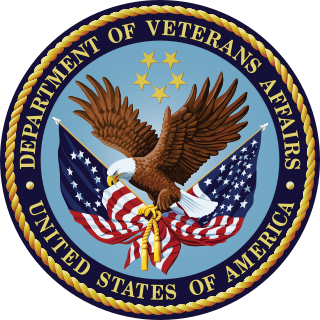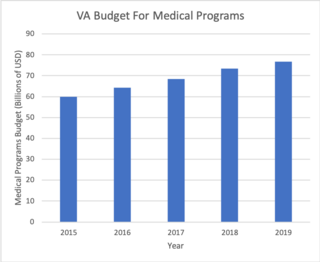
The United States Department of Veterans Affairs (VA) is a Cabinet-level executive branch department of the federal government charged with providing lifelong healthcare services to eligible military veterans at the 170 VA medical centers and outpatient clinics located throughout the country. Non-healthcare benefits include disability compensation, vocational rehabilitation, education assistance, home loans, and life insurance. The VA also provides burial and memorial benefits to eligible veterans and family members at 135 national cemeteries.

A military discharge is given when a member of the armed forces is released from their obligation to serve. Each country's military has different types of discharge. They are generally based on whether the persons completed their training and then fully and satisfactorily completed their term of service. Other types of discharge are based on factors such as the quality of their service, whether their service had to be ended prematurely due to humanitarian or medical reasons, whether they had been found to have drug or alcohol dependency issues and whether they were complying with treatment and counseling, and whether they had demerits or punishments for infractions or were convicted of any crimes. These factors affect whether they will be asked or allowed to re-enlist and whether they qualify for benefits after their discharge.

The Veterans Health Administration (VHA) is the component of the United States Department of Veterans Affairs (VA) led by the Under Secretary of Veterans Affairs for Health that implements the healthcare program of the VA through a nationalized healthcare service in the United States, providing healthcare and healthcare-adjacent services to veterans through the administration and operation of 146 VA Medical Centers (VAMC) with integrated outpatient clinics, 772 Community Based Outpatient Clinics (CBOC), and 134 VA Community Living Centers Programs. It is the largest division in the department, and second largest in the entire federal government, employing over 350,000 employees. All VA hospitals, clinics and medical centers are owned by and operated by the Department of Veterans Affairs, and all of the staff employed in VA hospitals are federal employees. Because of this, veterans that qualify for VHA healthcare do not pay premiums or deductibles for their healthcare but may have to make copayments depending on the medical procedure. VHA is not a part of the US Department of Defense Military Health System.

The Veterans Benefits Administration (VBA) is an agency of the U.S. Department of Veterans Affairs. It is responsible for administering the department's programs that provide financial and other forms of assistance to veterans, their dependents, and survivors. Major benefits include Veterans' compensation, Veterans' pension, survivors' benefits, rehabilitation and employment assistance, education assistance, home loan guaranties, and life insurance coverage.
Social Security Disability Insurance is a payroll tax-funded federal insurance program of the United States government. It is managed by the Social Security Administration and designed to provide monthly benefits to people who have a medically determinable disability that restricts their ability to be employed. SSDI does not provide partial or temporary benefits but rather pays only full benefits and only pays benefits in cases in which the disability is "expected to last at least one year or result in death." Relative to disability programs in other countries in the Organisation for Economic Co-operation and Development (OECD), the SSDI program in the United States has strict requirements regarding eligibility.

The Disabled American Veterans (DAV) is an organization created in 1920 by World War I veterans for disabled military veterans of the United States Armed Forces that helps them and their families through various means. It was issued a federal charter by Congress in 1932. It currently has over 1 million members. As a 501(c)(4) social welfare organization, it is outside the purview of – and therefore not rated by – Charity Navigator. DAV's Employer Identification Number (EIN) is 31–0263158.

The United States Court of Appeals for Veterans Claims is a federal court of record that was established under Article I of the United States Constitution, and is thus referred to as an Article I tribunal (court). The court has exclusive national jurisdiction to provide independent federal judicial oversight and review of final decisions of the Board of Veterans' Appeals.
Richardson v. Perales, 402 U.S. 389 (1971), was a case heard by the United States Supreme Court to determine and delineate several questions concerning administrative procedure in Social Security disability cases. Among the questions considered was the propriety of using physicians' written reports generated from medical examinations of a disability claimant, and whether these could constitute "substantial evidence" supportive of finding nondisability under the Social Security Act.
Guillain–Barré syndrome (GBS) is a rapid-onset muscle weakness caused by the immune system damaging the peripheral nervous system. Typically, both sides of the body are involved, and the initial symptoms are changes in sensation or pain often in the back along with muscle weakness, beginning in the feet and hands, often spreading to the arms and upper body. The symptoms may develop over hours to a few weeks. During the acute phase, the disorder can be life-threatening, with about 15% of people developing weakness of the breathing muscles and, therefore, requiring mechanical ventilation. Some are affected by changes in the function of the autonomic nervous system, which can lead to dangerous abnormalities in heart rate and blood pressure.

Euthanasia in Canada in its legal voluntary form is called Medical Assistance in Dying (MAiD) and it first became legal along with assisted suicide in June 2016 for those whose death was reasonably foreseeable. In March 2021, the law was further amended by Bill C-7 which to include those suffering from a grievous and irremediable condition whose death was not reasonably foreseeable. According to the Fourth Annual Report on MAID, there were 13,241 MAID deaths reported in Canada in 2022.

The United States has compensated military veterans for service-related injuries since the Revolutionary War, with the current indemnity model established near the end of World War I. The Department of Veterans Affairs (VA) began to provide disability benefits for post-traumatic stress disorder (PTSD) in the 1980s after the diagnosis became part of official psychiatric nosology.

The Board of Veterans' Appeals (BVA) is an administrative tribunal within the United States Department of Veterans Affairs (VA), located in Washington, D.C. Established by Executive Order on July 28, 1933, it determines whether U.S. military veterans are entitled to claimed veterans' benefits and services. The Board's mission is to conduct hearings and decide appeals properly before the Board in a timely manner. The Board's jurisdiction extends to all questions in matters involving a decision by the Secretary under a law that affects a provision of benefits by the Secretary to Veterans, their dependents, or their Survivors. Final decision on such appeals are made by the Board based on the entire record in the proceedings and upon consideration of all evidence and applicable provisions of law and regulation. The Board's review is de novo.

Sanchez-Benitez vs. West is a United States Court of Appeals for Veterans Claims case that dealt with the general requirement of a formal diagnosis for service connection.

Thun vs. Peake is a United States Court of Appeals for Veterans Claims case that dealt with extra-schedular evaluations and the VA Schedule for Rating Disabilities.

Buchanan v. Nicholson, 451 F.3d 1331 is a United States Court of Appeals for the Federal Circuit case that dealt with the credibility of lay evidence as it pertains to Veterans claims.

Barr vs. Nicholson is a United States Court of Appeals for Veterans Claims case that dealt with the competence of a Veteran's lay testimony to provide lay evidence. The court held that lay evidence can be competent depending on the type of disability claimed by a claimant. Specifically, the court held that lay people are competent to identify varicose veins that are "unnaturally distended or abnormally swollen and tortuous."

Charles vs. Principi is a United States Court of Appeals for Veterans Claims case that dealt with competency and VA's duty to assist.

Reonal vs. Brown is a United States Court of Appeals for Veterans Claims case that dealt with the credibility and weight assigned to medical opinions.

The M21-1 Adjudication Procedures Manual details policies and procedures for Veterans Benefits Administration (VBA) staff who develop and adjudicate U.S. veterans' disability benefit claims.
Arellano v. McDonough, 598 U. S. 1 (2023), is a United States Supreme Court case in which the Court held that 38 U.S.C. § 5110(b)(1), a provision relating to VA disability compensations, is not subject to equitable tolling.












